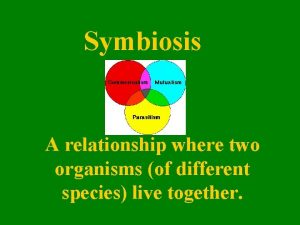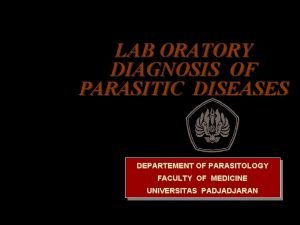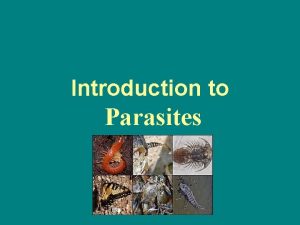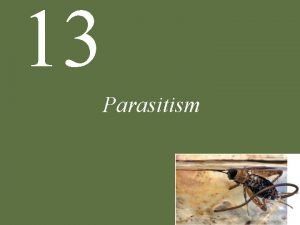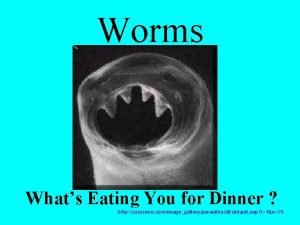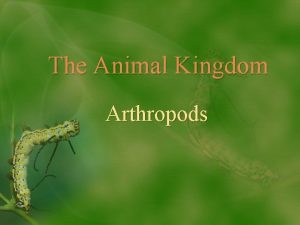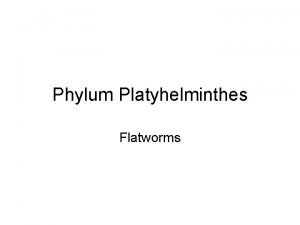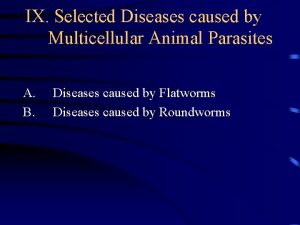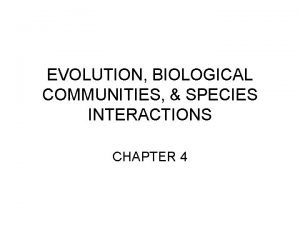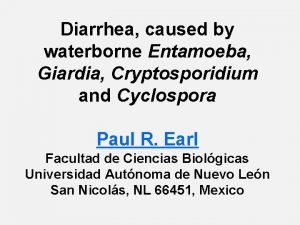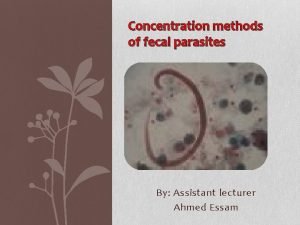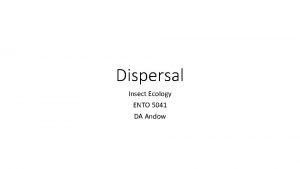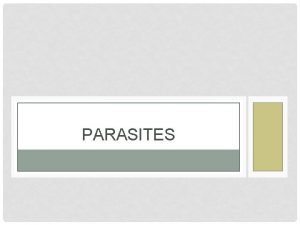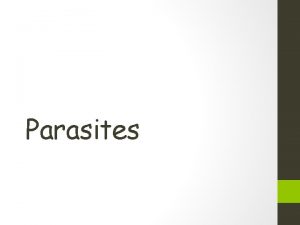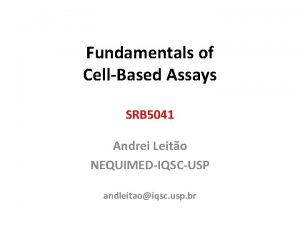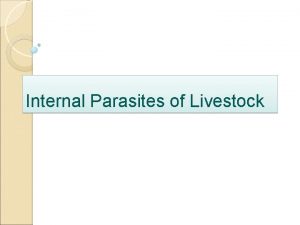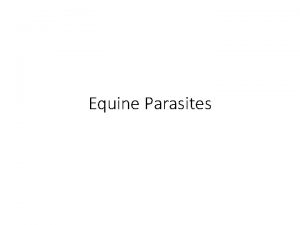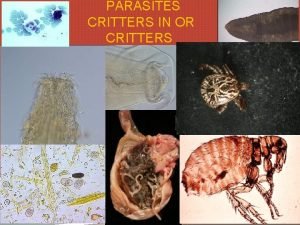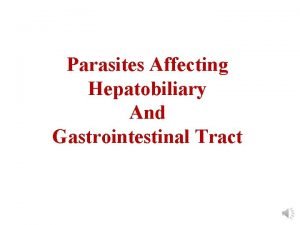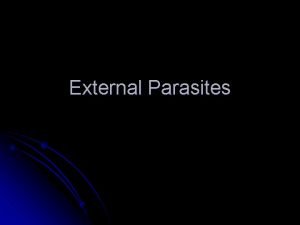Parasites Ento 5041 DA Andow Types of parasites















- Slides: 15

Parasites Ento 5041 DA Andow

Types of parasites in relation to arthropods • Microparasites • Parasites of arthropods (insect pathogens) • Parasites transmitted by arthropods (insect vectors) (animal disease, plant disease) • Macroparasites • Arthropods as parasites – traditional view (hematophagous arthropods) • Arthropods as parasites – expanded view (some herbivores)

Fuxa and Tanada 1987, p. 163

Nuclear Polyhedrosis Virus Bacillus thuringiensis https: //wimastergardener. org/article/bacillus-thuringiensis-bt/

Beauvaria bassiana

Protozoa, Microsporidia, Nosematidae, Nosema bombycis Control

Brown planthopper, Nilaparvata lugens Brachypter Macropter Agamermis unka, Nematoda, Mermithidae

Disease epidemiology • Central role of horizontal transmission • necessary for persistence –need to colonize new hosts to persist • because host is the environment, transmission occurs by “contact” between infective hosts and susceptible hosts • Vertical transmission • disease cannot persist indefinitely – lineages ultimately die out • therefore some kind of horizontal transmission must occur (or disease is transient)

Disease epidemiology • Density dependent horizontal transmission (SI/SIR model of disease dynamics) • S, Susceptible (never been infected, not immune) • I, Infected and infective • R, Resistant (have developed immunity) • Transmission is proportional to βSI • Depends on the number of infected individuals (“contact process”) • Frequency-dependent horizontal transmission • Sexually transmitted diseases- depends on proportion of the opposite sex that is infected

Disease epidemiology • Density dependent horizontal transmission • S, Susceptible (never been infected, not immune) • I, Infected and infective • Threshold host density (SI model) • Transmission is proportional to βSI • R 0 = net reproductive rate of the disease (per capita) • a = disease-induced host mortality • b = natural host mortality • γ = host recovery from disease • R 0 ≥ 1 for disease to persist; set R 0 = 1 and rearrange to find S • NT = threshold density (minimum density of susceptible hosts for the disease to persist

Disease epidemiology • Frequency-dependent horizontal transmission • No threshold host density • Transmission is proportional to βS I/(S+I) • R 0 = net reproductive rate of the disease (per capita) • a = disease-induced host mortality • b = natural host mortality • γ = host recovery from disease • R 0 ≥ 1 for disease to persist; hard to rearrange to find S. Trick: suppose there is no disease in the population and disease is introduced. Then (S+I) = S, and R 0 is independent of host density! • No threshold!

Evolution of virulence (disease-induced mortality rate) • Myxomatosis/mosquito/rabbit (Fenner 1983, Levin & Pimentel 1981) • Evolution of reduced virulence • Current view: Balance between virulence and transmission (NOT a general evolutionary tendency to become benign)

Some Definitions Disease – signs or symptoms of infection Pathogen (parasite) – disease-causing agents Prevalence - number or proportion of hosts in a defined population that are afflicted with a disease at a given point in time. It depends on both the proportion of hosts that become afflicted with the disease and the duration of the disease. Incidence - number of new cases of disease in a defined population during a given interval of time. Mortality rates: Gross death rate - number of deaths from all causes during a specified unit of time divided by the total number of individuals in the population. Cause-specific mortality rate - number of deaths from a specified cause (such as disease, etc. ) during a specified unit of time divided by the total number of individuals in the population. Age-specific death rate - number of deaths among individuals of a specific age divided by the total number of individuals of that age (see life tables, qx). Case-fatality rate - number of individuals dying from a particular disease divided by the total number of individuals that have the disease.

Some More Definitions Transmission - the process(es) by which a pathogen or parasite is passed from a source of infection to a new host (includes movement and infection processes). Direct- pathogen transfers without the intervention of any other living agent Indirect- one or more intermediate hosts or vectors is involved Vertical- pathogen is transmitted from parent to offspring Horizontal- pathogen is transmitted from one individual to another, but not from parent to offspring Infection rate (R) - rate of disease increase per unit of infectious host per unit of time. Apparent infection rate (r) - rate of disease increase per unit of infected host per unit of time (n. B. , not all infected hosts are infectious). R is much more difficult to estimate than r. Virulence - aka disease-induced mortality (plant pathologists call this “infectivity”) Pathogenicity - the ability of a group or species or strain or isolate of pathogen to invade and injure host tissue (disease-producing power). This is often measured as a response in a population of hosts to a given inoculum of pathogen or parasite (e. g. , LD 50, LC 50 or LT 50).

Dietz, K 1987 The population dynamics of onchoceriasis. In RM Anderson, ed. , The population dynamics of diseases. Chapman & Hall, London, pp. 209 -241. Dobson, AP & PJ Hudson 1986 Parasites, disease and the structure of ecological communities. TREE 1: 11 -15. Fuxa, JR and Y Tananda (eds) 1987 Epizootiology of insect diseases. Wiley, NY References Cited on Disease Transmission Anderson, R. M. & R. M. May. 1981. The population dynamics of microparasites and their invertebrate hosts. Proc. Royal Soc. London 291 B: 451 -524. Antonovics, J, Y Iwasa and MP Hassell. 1995. A generalized model of parasitoid, venereal and vector-based transmission processes. American Naturalist 145: 661 -675. Bailey, N. T. J. 1975. The mathematical theory of infectious diseases and its application (Griffin: London). Fenner, F. 1983. Biological control, as exemplified by smallpox eradication and myxomatosis (The 1983 Florey Lecture). Proc. Royal Soc. London 218 B: 259 -285. Getz, WM and J Pickering. 1983. Epidemic models: Thresholds and population regulation. American Naturalist 121: 892 -898. Levin, S. A. & D. Pimentel. 1981. Selection of intermediate rates of increase in parasite-host systems. American Naturalist 117: 308 -315. Kermack, W. O. & A. G. Mc. Kendrick. 1927. A contribution to the mathematical theory of epidemics. Proc. Royal Soc. London A 115: 700 -721.
 Emana ento
Emana ento Give example of mutualism
Give example of mutualism Kato-katz and kato thick procedure
Kato-katz and kato thick procedure Entamoeba histolytica common name
Entamoeba histolytica common name Parasite
Parasite Bacteria virus fungi and parasites
Bacteria virus fungi and parasites Curezone
Curezone Characteristics of parasites
Characteristics of parasites Turbularia
Turbularia Parasites alimentaires
Parasites alimentaires Multicellular animal parasites
Multicellular animal parasites Parasites of medical importance
Parasites of medical importance What do parasites eat
What do parasites eat Parasite consumer
Parasite consumer Chromatin
Chromatin Ova cysts and parasites
Ova cysts and parasites

